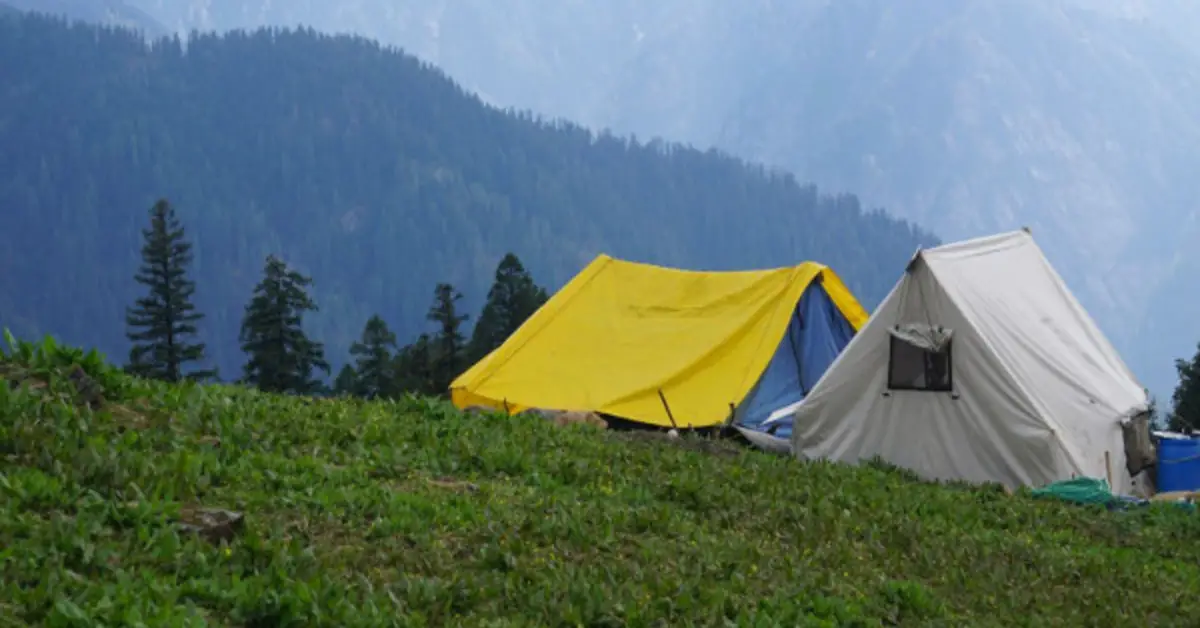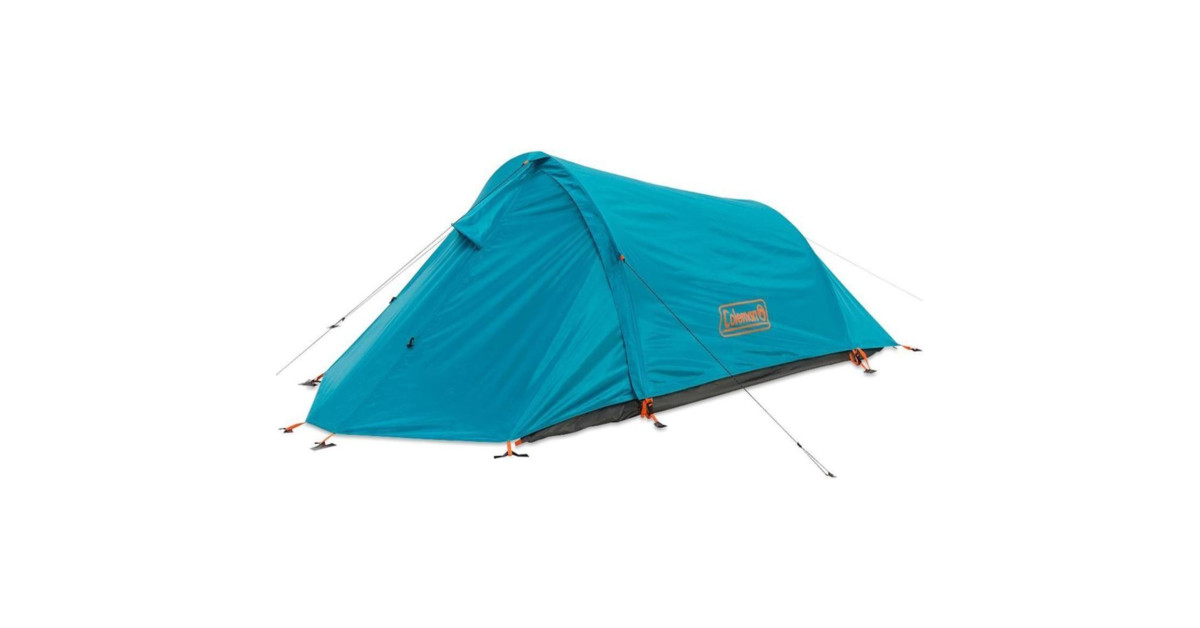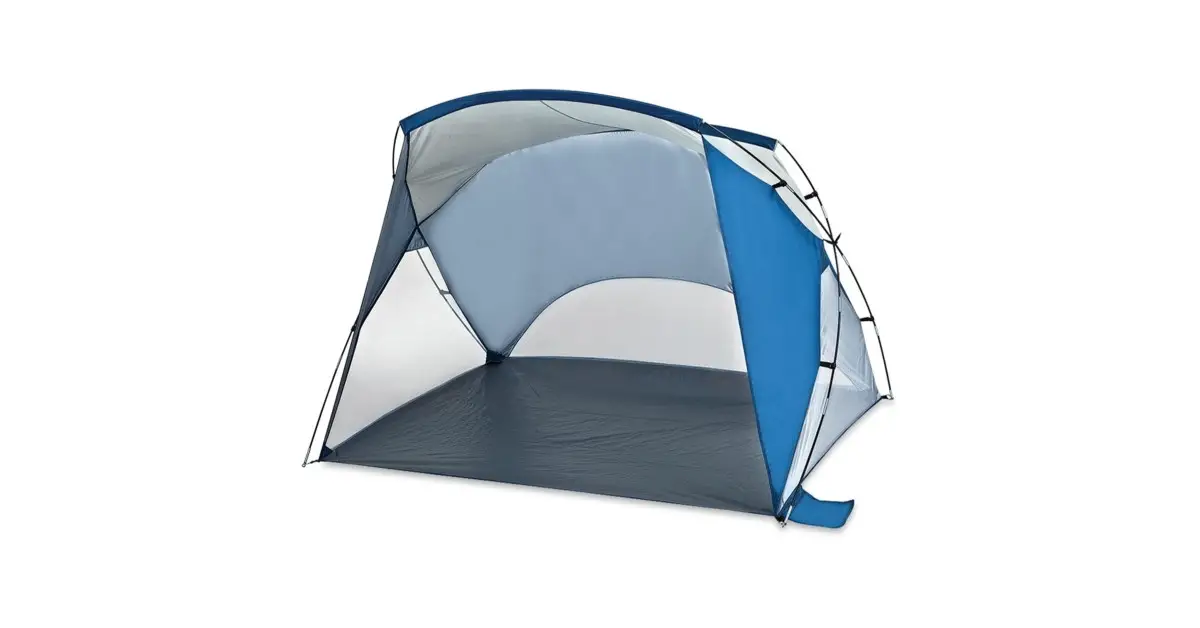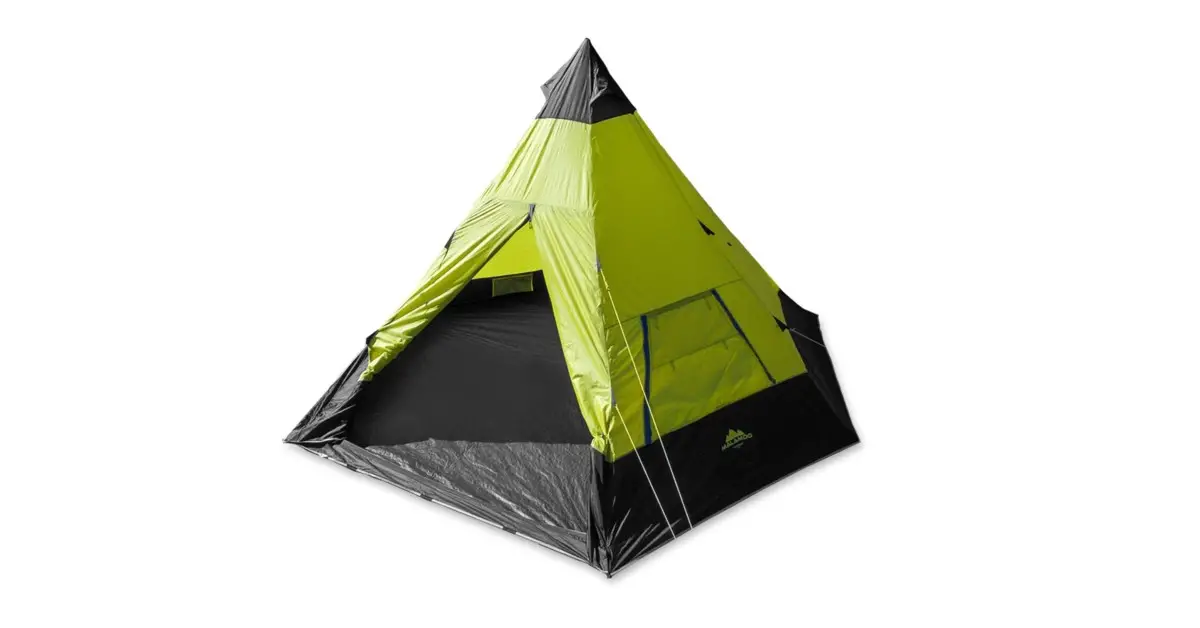
There are many different types of tents, but in this article, we will focus on the six most common ‘types’ of a tent, as well as two brands that have created a unique style and almost created a tent type of their own.
A-Frame Tents

A-Frame tents, also more commonly known as ridge tents, are probably the most traditional kind. It has a ridge that stretches across the length of the tent.
The ridge is supported by two poles on either end. Guy lines and tie-outs help stabilize the tent. This enables the tent to withstand inclement weather to some degree.
Originally made from canvas, these tents could last up to 10 years of wear and tear.
More modern versions feature aluminum poles and ridges while the tent itself is made from either nylon or polyester, treated with a urethane coating to make it waterproof.
Features
This type of tent features two sturdy poles that hold the weight of the ridge and the tent itself. The corners of the tent are tied down to stakes placed in the ground.
Additional stakes may be added around the perimeter of the tent for added strength and stability. The inclined slopes formed by the A-Frame make sure there is no water or rain buildup when it rains.
Pros
- Easy to set up
- Handles rain and snow pretty well
- Fairly sturdy and stable
Cons
- Heavy
- Low headroom
- Bulky when packed
Dome Tents

The most popular type of tent, especially for hikers and backpackers. They come in a wide range of sizes and are really easy to set up. The tent is supported by two poles which are curved to form the “dome”.
Some models may also feature a tiny porch or vestibule area, which could be used as a mudroom or for extra storage space. A rainfly is secured to the tent by attaching to the poles which are situated outside the tent.
This gives extra protection for when it rains while allowing cold air to come through the window, which is usually covered in some mesh material to keep the bugs out.
Features
Dome tents feature two curved poles that are curved and crossed across each other. Then ends are locked into the tent’s canvas to hold it in place.
Ample headroom allows for better movement inside the tent compared to a ridge type. The dome also repels rain and water, thus eliminating the buildup of water on top.
Pros
- Lightweight
- Easy to assemble and takedown
- Good amount of headroom
Cons
- Not too stable, especially against strong winds
- Limited size
- Small porch or vestibule space
Hiking Tents

Hiking tents or backpacking tents are made from the lightweight material, making them ideal for taking on extended hikes or long camping trips.
These tents are perfect for when you need to hike a long way, and carrying a minimal tent makes all the difference.
Since they are made from high-quality material, they tend to be more durable and last much longer.
Generally, hiking tents carry a low profile. When you get in, you can only lie down. You could probably sit up, but chances are you will be touching the roof if you’re in a hiking tent.
If you need a no-frills type of tent minus all the bells and whistles, just the bare necessities, you should definitely bring along your hiking tent.
Features
Backpacking tents are ultra-lightweight for ease of carrying on long hikes up a mountain or the backcountry.
It has to be lightweight, rugged to withstand any condition, and easy to set up. It is also the more affordable type of tent, making it a good choice for people just starting out their hiking journey.
Pros
- Ultra Lightweight allows for easy carrying on long hikes
- Quick to set up, when you’re in a hurry
- Rugged, could take on wear and tear
Cons
- Low ceiling means less space to move around
- Overall size is small, could probably fit only one person
- A bit pricier than other tent types
Popup Tents

As the name suggests, popup tents are the “instant coffee” in the camping and hiking circles. After all, you just “pop it up” by taking it out of the bag, and there’s your tent, all set up.
These are excellent for a quick setup at a festival where you don’t want to fuss about setting up camp for the night.
For those who want to enjoy a quick summer camping trip, carry your popup tent and get set up in no time.
Likewise, packing it up for when you are ready to leave is just as easy. Just make sure there is no rainfall or gustiness anticipated. Otherwise, you’re in for a rough night at camp.
Features
Popup tents are a relatively new member of the tenting industry. People crave “instant” everything nowadays. Clearly, selecting a tent is no exception.
Popups can be set up in no time at all. It is also lightweight, making it easy to carry around on your next camping trip. It can be folded and kept in a small bag for ease of transport.
Pros
- Ultra Lightweight, weighs next to nothing
- Set up can be done quickly
- Extremely portable due to its tiny packed size
Cons
- Weather resistance is limited
- Can be unstable
- Poor quality material construction
Beach Tents/Shelters

Beach tents or shelters are not meant for camping, but rather to be used at the beach. The purpose of this type of tent is to block the sun for those beachgoers who want to cool down after a whole day basking in the sun.
This tent is not meant to stand up to wind and rain. Therefore, it is not ideal for camping.
Tents meant for use on the beach are not that durable compared to tents used for camping or hiking. The material used is low quality, which shouldn’t be an issue if you’re only going to use it on the beach.
As long as it serves its purpose of blocking the sun, wind, or even sand flying around, beach tents work perfectly well in this situation.
Features
Since this type of tent is meant specifically for the beach, one of its features is to keep sand away from you when you’re not in the water. The other main feature is to block the sun when you’ve had enough sunshine for the day.
Pros
- Keeps you from stepping on hot sand
- Protects you on a windy day
- Easy assembly and disassembly
Cons
- Not suitable for camping use
- Materials used are usually not that durable
- More often than not, it isn’t waterproof
Teepees

Once considered a novelty item in the tent industry, teepee tents are now evolved into one of the more practical types. It is based on the original teepee huts, which were made popular by the North American Indian tribes.
It utilizes a single pole in the center and a number of guy lines attached to stakes in the ground.
Today’s version of the teepee tent generally utilizes canvas or maybe other durable fabric that is made waterproof by applying a urethane coating to its surface. This is to ensure that you remain dry inside even when there is torrential rain pouring outside.
Features
Teepee tents are usually made from cotton or canvas material. These tents tend to have a high ceiling and also a high pitching point.
Despite this, it is quite easy to pitch and can accommodate a good number of people. The taller the teepee tents are, the less stable they tend to be.
Pros
- Has plenty of room for a small group of campers
- Roomy, with a high ceiling
- Easy to pitch
Cons
- It is usually heavy
- High pitching point
- Flooring material normally not included
Inflatable Tents

This is another one of the newer types of tent that has cropped up in recent years. Instead of the traditional aluminum or plastic poles found in older tents, air tubes are inflated to form the supports that hold the tent in place and give it shape.
This eliminates the risk of broken poles while setting up camp. Inflatables are mostly used in glamping or maybe even backyard camping for the family.
Since this is a fairly new tent design, there is a tendency that it is going to be pricier than most common tents.
Features
This type of tent requires an air pump to inflate. Once you’ve filled it with enough air, that is all the setup you need to do.
It is very rare to spot an inflatable tent in a campground, most probably due to the high price tag that comes with it.
Pros
- Easy to set up-just pump it up with air, and you’re good to go
- Spacious, and most likely used in “glamping”
- Comes in many shape and size variants
Cons
- Starts at a high price point
- Requires an air pump to set up
- It can pop when pricked or poked with a sharp object
Rooftop Tents

Another fairly recent addition to the tent lineup are Rooftop Tents, or Car-Top Tents. As the name implies, the tent is placed on top of your car or truck. The only condition is that your car is equipped with roof bars or roof rails.
You get up on the rooftop with the help of a ladder, which comes with the tent assembly. Otherwise, you’ll have to bring your ladder each time you want to go camping in your Rooftop Tent.
Features
Many will wonder how a car can support the weight of a tent and maybe 2 or 3 people on top of that. The answer is in the roof rail, where supports for the tent are attached to.
Being able to set up your tent high above the ground gives you an extra measure of being safe from insects and wild animals.
Pros
- Keeps you dry when it rains and the ground is soaking wet
- Extra protection from insects and wild animals
- It can be set up anywhere, provided you take your car
Cons
- Heavy
- Expensive
- Takes time to initially set up
Oztent

Though Oztent is a brand, they have also engineered a unique style of tent. Oztent has set itself apart by pioneering the 30-second tent. This new line of tents allows for a quick setup without compromising safety.
Utilizing top-quality materials, following the highest standards of manufacturing and engineering, and testing their products thoroughly, Oztent has come up with a product that ticks all the marks for world-class camping and hiking gear.
Although they have started branching out to other outdoor sports activities like kayaking and 4-Wheel Driving, Oztents is still primarily about camping and hiking.
Their tents are the flagship product that they are most known for.
Coleman Tents

Coleman Tents are another brand that has been around for a while. They have their own line of quick-to-set-up tents that can be assembled in under a minute.
They have made leaps and bounds in making their tents a top-of-the-line product.
One of those measures is to ensure that their tents are absolutely waterproof, could withstand winds up to 35 mph, and added zipper cuffs to protect the door from heavy rain.
They also developed a tub floor design to ensure that you remain dry even with large amounts of rainfall.
Apart from their tents, Coleman is also well-known manufacturers of sports equipment. They take pride in the quality of their equipment at an affordable price point. This makes Coleman a very popular brand of hiking and camping equipment.
Which type of tent is best?
There is no best type when it comes to your choice of tent. It all depends on your use case. If you plan on hiking, it would be impractical to take a bulky tent like a teepee or an A-Frame. A backpacking tent or a dome tent would be more practical for this purpose.
When you need sunshade at the beach, a lightweight beach tent will make the most sense. If you’re in a hurry and need a quick setup, a popup tent would be advisable.
To sum it up, the best tent is whatever serves your purpose for the particular hiking, camping, or glamping trip you are planning next.
